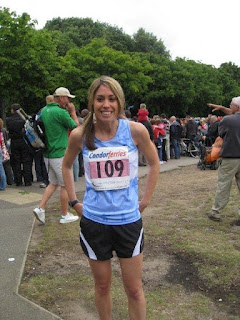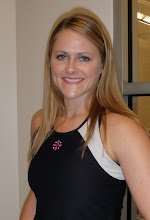During my first interview with Corinne, I learned how she went from the 7-minute shuffle around the block (right after surgery) to training for a half-marathon coming up later this month!
1. What is the heart condition that you have?
I was diagnosed with an atrial septal defect or ASD which is a hole between the top chambers of the heart. The hole was 2cm x 3cm - so pretty large and meant a large proportion of blood was flowing backwards though my heart causing it to enlarge. The heart condition is classed as a congenital defect meaning something I was born with but had gone undetected for 27 years!
2. When did you notice something was not quite right in terms of your health? Had it affected your running and other workouts?
Soon after I had run the Berlin marathon in September 2009 in exactly the same time I had run the London marathon earlier in the year, I began to feel frustrated at my lack of progress. Little by little, I noticed small changes in my health such as increased fatigue, shortness of breath at rest and palpitations. I put these symptoms down to general tiredness and the stress of having a busy life. I continued to push myself with hard running, biking and swimming sessions, trying to keep up with other members of my triathlon club. Eventually I went to see my doctor and within two weeks, I was diagnosed with the hole in my heart.
3. Tell us about the surgery you had in order to fix your heart.
Doctors performed several tests and took their time to decide which was the best option for closing the hole. It was decided that open heart surgery was the only option. I had the choice of a vertical or horizontal incision in my chest. I opted for a vertical scar as this meant a better recovery especially for returning to swimming. Fear didn't take hold of me until I went down to the operating theatre. Previously, I had been effectively blocking out nerves. During the surgery my heart was stopped for 39 minutes and I was put onto a 'bypass' machine. I spent a period on intensive care and was eventually released from hospital after 8 days.
4. Recovery! Tell us what it was like and what you were thinking after the surgery and into your early recovery.
Recovery after the surgery was a roller-coaster of emotions! Sometimes I felt great, others I was exhausted and pain. Very quickly, I realized I wasn't invincible! All my thoughts were focused on getting better and achieving my goals. I had deferred a London marathon place and was desperate to to back to running. Before diagnosis, I had a clear plan of what I wanted to achieve and by when. Regularly reading these goals kept my spirits up in recovery. I was on countdown to my milestone dates: I was allowed to walk round the block after a week - I managed a whole 7 minute shuffle! Day by day, the distance increased and I began to feel stronger. I was in a lot of pain from my chest and neck but found it useful to concentrate on how lucky I was to have made it through such major surgery relatively well!


No comments:
Post a Comment